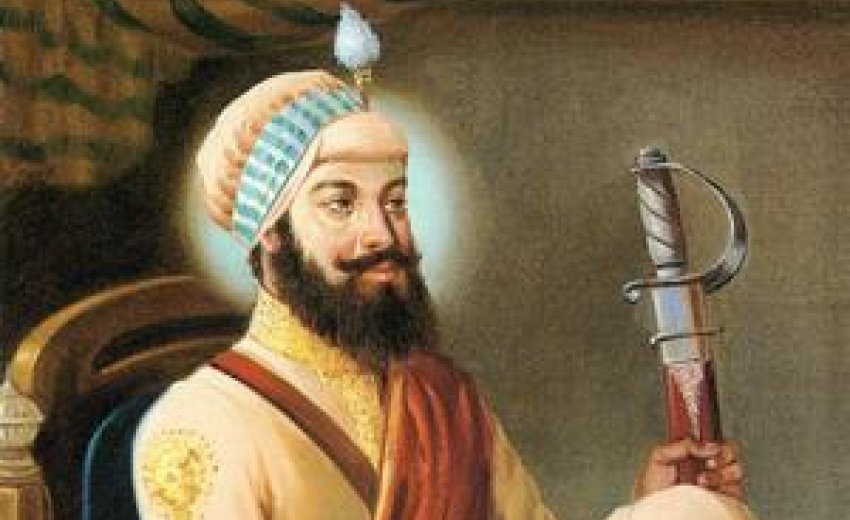Also
known as Saccha Badshah (emperor), Guru Hargobind Rai was the sixth
guru of Sikhs. Born on June 19 1595 (now July 5) at Guru ki Wadali,
Amritsar, he became guru on May 25 1606 following his father Guru Arjan
Dev’s teachings. He was 11 years old when his father was executed by
Mughal authorities during Jahangir’s reign.
 Guru
Hargobind was also the inventor of Taus, a musical instrument which was
similar to the sound of music. He was a brilliant martial artist and
avid hunter. He also founded the city of Kiratpur Sahib which falls in
the district Rupnagar.
Guru
Hargobind was also the inventor of Taus, a musical instrument which was
similar to the sound of music. He was a brilliant martial artist and
avid hunter. He also founded the city of Kiratpur Sahib which falls in
the district Rupnagar. 
After
Guru Arjan Dev’s martyrdom, Guru Hargobind Rai completely transformed
Sikhs from just spiritual beings to ferocious warriors. He encouraged
people to maintain physical fitness and keep themselves ready for physical
combat. He also built a fortress at Amritsar called Lohgarh (fortress of
iron).
He wore two swords of Miri and Piri. Miri
dignified temporal authority and Piri, spiritual authority. The same
philosophy was applied in the foundation of Akal Takht, the highest
temporal seat of Sikhs. He constructed Akal Takht in front of Harmandir
Sahib in 1606. Initially a platform, Akal Takht was about twelve feet, a
complete defiance of Mughal rule that none apart from Mughal emperor
could sit on an elevated platform above three feet.
It
is worth mentioning that Akal Takht’s platform was a fraction below
Darbar Sahib signifying that spirituality was always primary in Sikhism.
 Akal
Takht marked the beginning of Sikh militarization, Guru Hargobind added
lustre to Sikhism, he added marks of sovereignty to the symbols of
sainthood, including umbrella (chhatar) and kalgi. He administered
justice like a king and awarded; honours and punishment as well.
Akal
Takht marked the beginning of Sikh militarization, Guru Hargobind added
lustre to Sikhism, he added marks of sovereignty to the symbols of
sainthood, including umbrella (chhatar) and kalgi. He administered
justice like a king and awarded; honours and punishment as well. As
per Cunningham, "The genial disposition of the martial apostle led him
to rejoice in the companionship of a camp, in the dangers of war, and in
the excitements of the chase".
During the
guruship of Hargobind, Sikhs had formed a separate and independent
identity which had nothing to do with the contemporary Mughal
government.
Despite giving attention to
militarisartion, Guru Hargobind did not neglect preaching and spreading
of Sikh religion. He sent Sikhs to far of places to preach Sikhism.
Guru
was an excellent statesman and his darbar was known for its splendor.
During his time, martial training was imparted to the Sikhs,the Guru had
Risaldari (army) of three hundred horsemen and sixty gunners in course
of time. He had a stable of eight hundred horses. Jahangir was not
tolerable towards Sikhs as his father Akbar was.
He
could not tolerate the armed policy of Guru Hargobind and consequently
imprisoned him in the fort of Gwalior for almost one year where the Guru
had gone himself willingly in order to relieve Jahangir from his
illness. Sain Mian Mir interefered and asked Jahangor to release the
guru as his illness was long over. But the guru refused to leave the
fort without other 52 princes who had been confied for long. Ultimately,
the Mughals had to relent and all the princes were released. 

The occasion is celebrated as Bandi Chhorh (liberator) divas in the Sikh history, on the same day as Diwali.
After
Jahangir’s death, relations again turned bitter with the Mughal emperor
Shahjahan. During his lifetime, the Guru fought four battles. In all
the battles, Sikhs were victorious.
On the third
day of March 1644, (Bikrami 1701), Guru Hargobind called his followers
and passed on the gurgaddi to his son Guru Har Rai. The very same
evening Guru breathed his last.
A city Hargobindpur has also been named after him which he had won after defeating the Mughals.
Guru
Hargobind has always occupied a special position as he was the one who
transformed Sikh fraternity by introducing martial arts and weapons and
strengthened the principle of Miri and Piri.
